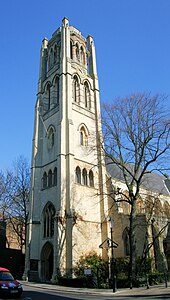
All Saints Notting Hill

| All Saints Notting Hill | |
|---|---|
 | |
 | |
| Location | Talbot Road, Notting Hill |
| Country | United Kingdom |
| Denomination | Church of England |
| Churchmanship | Anglo-Catholic |
| Website | All Saints Notting Hill |
| History | |
| Founder(s) | Samuel Walker |
| Dedication | All Saints |
| Associated people | Walter Passmore |
| Architecture | |
| Heritage designation | Grade II* |
| Designated | 29 July 1949 |
| Architect(s) | William White, with Sir George Gilbert Scott |
| Style | Gothic Revival |
| Years built | 1861 |
| Administration | |
| Province | Canterbury |
| Diocese | London |
| Episcopal area | Kensington |
| Archdeaconry | Kensington |
| Deanery | Kensington and Chelsea |
| Clergy | |
| Priest(s) | Philip Corbett SSC |
| Curate(s) | Bello Mahilum |
| Laity | |
| Reader(s) | Gladvin Allen |
All Saints Notting Hill is a Church of England parish church in Talbot Road, Notting Hill, London that is affiliated to the Anglo-Catholic Forward in Faith movement.[1] The church is built in a Victorian Gothic Revival style with striking polychromatic decoration. For heritage purposes the church is a Grade II* listed building.[2]

History
The building of All Saints' Church was begun in 1852 for the Reverend Dr Samuel Walker. Walker was a wealthy property speculator, one of several buying up land in the area that was then to be known as Kensington Park.[3]

The church was designed by architect William White, working with Sir George Gilbert Scott as to be the centrepiece of Walker's local property development, and a church without pew rents.[4]


Walker's property speculation in the area was a financial failure and he sold his interests to others speculating on property in the newly emerging area of Kensington Park.[5]

As a result, the church-building was left unfinished for a number of years during which time in some quarters it received the epthet "All-Sinners-in-the-Mud".[6]

All Saints was eventually completed in 1861 at a cost of £25,000, without its spire,[4] for the incumbency of Reverend John Light of Trinity College Dublin.[7]

The tower is 100 feet (30 m) high and is said to resemble the Medieval Gothic Belfry of Bruges, Belgium.[8]

All Saints suffered serious bomb damage in The Blitz of World War II,[9] along with neighbouring buildings including Pinehurst Court, at 1–9 Colville Gardens. The first bombs fell on 26 September 1940, and the church was hit again in March and June 1944. The Lady Chapel and the south transept chapel were destroyed.[4] Restoration work was completed in 1951.[10]

Clergy
From 1931 to 1961 the vicar was the outgoing and gregarious Fr John Twisaday, who established the high church worship tradition at All Saints. From January 2025 Rev. Charles Card-Reynolds will be Vicar.[11]

Vicars
- 1861–85 John Light
- 1885–96 Robert Trench
- 1896–1907 Philip Herbert Learyk
- 1907–31 Herbert Ridley
- 1932–61 John Herbert Cloete Twisaday
- 1961–66 John Herbert Brewer
- 1966–67 John Henry Dixon
- 1967–74 Peter Clark
- 1976–2018 John Brownsell
- 2019-2024 Philip Corbett
- 2025- Charles Card-Reynolds
Decoration and fittings
The chancel has paintings by Henry Holiday.[9][12]

Notable parishioners
• Walter Passmore (1867–1946), a singer and actor best known for his comic baritone roles in Gilbert and Sullivan operas with the D'Oyly Carte Opera Company, was a choirboy at All Saints.[13]

Organs and Organists
Organs

- 1862-3. The church's first organ was built by Gray & Davison having first been displayed at the 1862 International Exhibition.[14] It was located in the south transept of the church. This position led to some criticism:
- The north transept of All Saints', Notting Hill, was designed by Mr. White, specially for the reception of the organ, and with this end in view he fenestrated it with a large traceried rose placed high up in the wall [...] the authorities caused the organ to be placed in the south transept, thus completely blocking up a very beautiful four-light window. The effect of the opposite transept, with the blank wall space left perfectly bare, is very unpleasing. [...] The organ in question, by Gray and Davison, occupies an elevated position, and has the somewhat unusual appendage (for a modern instrument) of a choir organ.[15]
- 1902. A new three-manual organ by Norman and Beard was installed,[16] in the north chancel and north transept.[17]
- 1952. The organ was reconstructed by Percy Daniel & Co, Clevedon, with the pipe-work placed inside the tower speaking into the church via an opening onto the west gallery.[18]
Organists
- (n.d.) Henry John Gauntlett (9 July 1805 Wellington – 21 February 1876 Kensington). Mus.D. (Lambeth, 1843) [19]
- (n.d.) George Benjamin Allen (21 April 1822 London – 30 November 1897 Brisbane) Mus.B. (Oxon, 1852).[19]
- (1873–86) Edward Henry Birch. (12 December 1849 Uxbridge – 9 April 1934 Kensington) Mus.B. (Oxon, 1875).[19]
- (1885/6?-at least 1892) George Ernest Lake (29 May 1854 London – 15 March 1893 London).[19]
- (noted In post in1902 & 1921) Richard William Robertson (c.1880 Kensington – 11 May 1936 St Pancras).[19][20]
- (1905-) Henry Scott-Baker (1880 London -?) A.R.A.M., L.R.A.M., A.R.C.O.[19][21]
- (noted In post in 1921) Benham Blaxland (1861 Parramatta – 1926 London).[19][22]
- (1936–42) Joseph Hurst Bannister (1882 Burton-upon-Trent – 2 August 1942 Lindfield).[19]
- (noted in post in 1957/8) Nicholas Jackson (1934– ), 3rd Bt (1979). LRAM.[23][24][25]
- (1975) Organist post advertised jointly with St John's Notting Hill, £200p.a.[26]
- (noted in post 2005) Andrew Tait GGSMD MA MMus.[27]
- (2021–23) Christopher Myhill (1980- )[28]
Assistant Organists
- 1877-79 Henry William Richards (16 April 1865, Notting Hill) - 4 January 1956. Reading). Mus.D. (Dunelm, 1903), Hon.R.A.M., Hon.R.C.M., F.R.C.O.[19]
- September 1959 Assistant organist post advertised at £40 p.a.[29]
Notes

- ^ "Homepage". All Saints Notting Hill. Retrieved 5 August 2015.
- ^ Historic England. "All Saints Church (Grade II*) (1080701)". National Heritage List for England. Retrieved 5 August 2015.
- ^ 'The Ladbroke estate: The 1850s. Land purchase and development by Blake and Dr. Walker, 1850–3'. Survey of London: Volume 37, Northern Kensington. 220-235. Originally published by London County Council, London, 1973. Online resource, accessed 29 October 2023.
- ^ a b c Denny 1993, p. 70
- ^ 'The Ladbroke estate: Building boom and collapse in the early 1850's. Land purchase and development by Blake and Dr. Walker, 1850–3'. Survey of London: Volume 37, Northern Kensington. 220-235. Originally published by London County Council, London, 1973. Online resource, accessed 29 October 2023.
- ^ Shepherd 1973, pp. 298–332.
- ^ "All Saints' Church Notting Hill". The Illustrated London News. 8 September 1866. p. 245. Retrieved 20 February 2010.
- ^ Mitton 2007, p. 97.
- ^ a b Pevsner 1952, p. 297.
- ^ "History of All Saints". All Saints Notting Hill. Retrieved 11 June 2023.
- ^ Parish website announcement. Online resource, accessed 11 November 2024.
- ^ Historic England. "All Saints Church, Clydesdale Road W11 (1080701)". National Heritage List for England. Retrieved 20 February 2010.
- ^ Walters, Michael, ed. (1995). "Gilbertian Gossip". Gilbert and Sullivan Newsletter Archive. Department of Mathematics, Boise State University. Retrieved 20 February 2010.
- ^ The National Pipe Organ Register: N17507
- ^ T. Francis Bumpus London Churches: ancient and modern. (London: Bumpus, 1883) 128–129
- ^ Frederick W. Thorsby Dictionary of Organs and Organists, 131 (London: G.A. Mate, 1921). Online resource, accessed 24 October 2023.
- ^ 'Organ News' . Musical Opinion and Music Trade Review Jun 1902; 25, 297 p.671.
- ^ National Pipe Organ Register: D03538. Online resource, accessed 23 October 2023.
- ^ a b c d e f g h i W. B. Henshaw Biographical Dictionary of the Organ, Bardon Music. Online resource, accessed 26 October 2023,
- ^ A Dictionary of Organs and Organists Frederick W Thorsby (London : G.A. Mate, 1921) p.141
- ^ 'Organist Choirmaster and Choir Appointments' The Musical Times 1905-08-01: Vol 46 no.750 p.539.
- ^ Frederick W. Thorsby Dictionary of Organs and Organists, 309 (London: G.A. Mate, 1921). Online resource, accessed 24 October 2023.
- ^ The Musical Times Vol. 98, No. 1377 (Nov., 1957), 640. Vol. 99, No. 1384 (Jun., 1958), 344.
- ^ Jackson baronets, of Eagle House (1913)
- ^ 'Sir Nicholas Fane St. George Jackson, 3rd Bt.' in Mosley, Charles (ed) Burke's Peerage, Baronetage & Knightage (Wilmington: Burke's Peerage, 2003)
- ^ The Musical Times, Jan., 1975, Vol. 116, No. 1583 (Jan., 1975), 87
- ^ UCL Singers concert programme, 21 March 2005. PDF. Online resource, accessed 23 October 2023.
- ^ LinkedIn profile. Online resource, accessed 24 October 2023.
- ^ The Musical Times, Vol. 100, No. 1399 (Sep., 1959), 494.
References
- Denny, Barbara (1993). Notting Hill and Holland Park Past. Historical Publications. p. 70. ISBN 0-948667-18-4.
- Mitton, Geraldine (2007). The Kensington District. Project Gutenberg. (EBook 21643)
- Pevsner, Nikolaus (1952). London. The Buildings of England. Vol. 2 Except the Cities of London and Westminster. Harmondsworth: Penguin Books. ISBN 0-14-071006-X.
- Shepherd, FHW, ed. (1973). The Portobello and St Quintin estates. Survey of London. Vol. 37 Northern Kensington. London: London County Council. pp. 298–332.
External links
51°30′59″N 0°12′10″W / 51.5165°N 0.2029°W

- Buildings and structures in Notting Hill
- Church of England church buildings in the Royal Borough of Kensington and Chelsea
- Diocese of London
- Grade II* listed churches in London
- Grade II* listed buildings in the Royal Borough of Kensington and Chelsea
- George Gilbert Scott buildings
- Gothic Revival church buildings in London
- Churches bombed by the Luftwaffe in London
- History of the Royal Borough of Kensington and Chelsea
- 1861 establishments in England
- Anglo-Catholic church buildings in the Royal Borough of Kensington and Chelsea
- Anglo-Catholic churches in England receiving AEO
See what we do next...
OR
By submitting your email or phone number, you're giving mschf permission to send you email and/or recurring marketing texts. Data rates may apply. Text stop to cancel, help for help.
Success: You're subscribed now !
